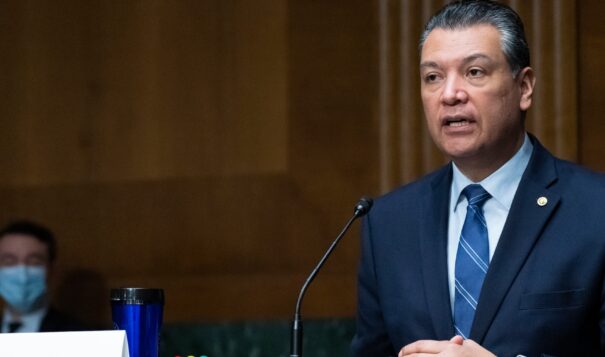News Based on facts, either observed and verified directly by the reporter, or reported and verified from knowledgeable sources.
Water talks in the Senate
 Sen. Alex Padilla, D-Calif., speaks during a Senate Health, Education, Labor and Pensions confirmation hearing for Julie Su to be the Labor Secretary, on Capitol Hill, Thursday, April 20, 2023, in Washington. (AP Photo, Alex Brandon)
Sen. Alex Padilla, D-Calif., speaks during a Senate Health, Education, Labor and Pensions confirmation hearing for Julie Su to be the Labor Secretary, on Capitol Hill, Thursday, April 20, 2023, in Washington. (AP Photo, Alex Brandon)
Three different committees will discuss water this week and bring in Indigenous leaders to testify
Access to clean, drinking water and running water in Indigenous nations has always been an issue, but it wasn’t until the COVID-19 pandemic that it moved to the forefront of the American consciousness. Congress and the White House were moved to act. Millions of dollars for water infrastructure were poured into Indigenous nations through the American Rescue Plan, Bipartisan Infrastructure bill and the Inflation Reduction Act.
“The good news is there’s funding for new projects, but historically there has not been funding or support for ongoing operations and maintenance. Over time, that can be pretty detrimental to health and safety when it comes to water for different tribes and we want to dig into that a little bit,” said U.S. Sen. Alex Padilla, D-California, to ICT.
This week starts the first hearing for an unofficial water week on the hill. Padilla is chair of the subcommittee on Fisheries, Water and Wildlife under the Senate Committee on Environment and Public Works.
There are 109 federally recognized Indigenous nations in what is now known as California. As chair, it was important for him to bring Indigenous voices on water issues to the forefront. On Wednesday, he will hold a hearing, Drinking Water Infrastructure and Tribal Communities, where tribal officials and experts will testify before the subcommittee.
The issues around water are vast, interconnected and often exasperated by the drought in the West.
“It’s a challenge to maintain water supply,” Padilla said. “California and throughout the West have been living through a sustained drought. What infrastructure exists in many places is aging, and impacting water quality, water safety.”
Padilla first came to water issues during his first elected position for the Los Angeles City Council. The city has the largest municipal water system in the country and, according to Padilla, is a leader when it comes to water efficiency, conservation and recycling.
“Far too many communities, including tribal communities, have never been adequately served when it comes to water,” he said. “Tribal communities tend to be more rural than others, making it more expensive to connect into broader infrastructure. Whether it’s a lack of infrastructure or sometimes lack of safe running water, some communities, including tribes, have to leave their communities and truck in water just for basic hygiene, just for basic daily drinking water for children. That’s unacceptable in the year 2023.”
U.S. Sen. Ron Wyden, chair of the Water and Power subcommittee, has a hearing also Wednesday about the impact of drought on access to drinking water. Chairman Jonathan Smith, Confederated Tribes of Warm Springs, is one of four on the witness panel.
Next week, the Senate Indian Affairs committee will have its own hearing on water according to Padilla.
“I think we’re in a unique time with a proper focus that we will want to maintain, hopefully, it’s not just a snapshot, but it’s an ongoing commitment,” Padilla said.
Tribal homes are 19 times more likely to lack indoor plumbing, said Padilla. This doesn’t include homes with lead water pipes that need to be updated. Going even further there are still issues with public water infrastructure that uses lead pipes.
“You can talk about replacing pipes in a home but if the water coming in from the water system is not to EPA standards, what good are the new pipes?” he said. “We really have to address it at all levels from, where’s the water supply? How are we transporting or distributing water from where we find it to where we need to in communities? Once it’s inside the pipes of a home and coming out of the tap, is it safe to drink? Do we have a sufficient supply? And is it affordable?”
